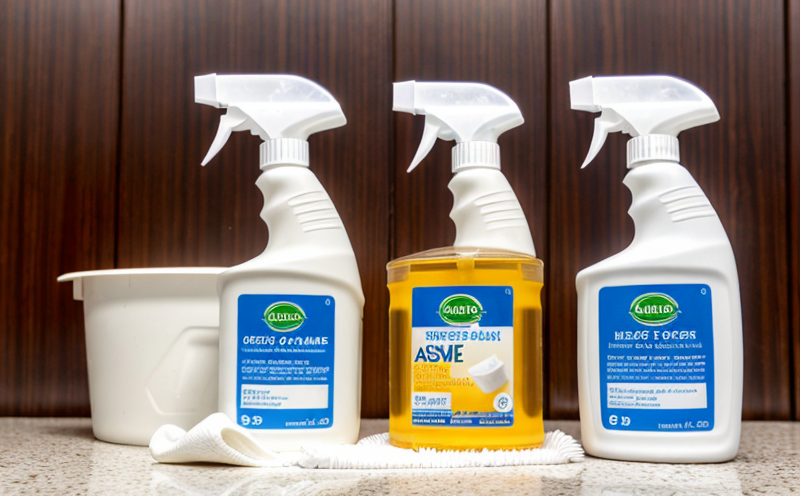EN 14562 Fungicidal Testing on Instruments and Surfaces
The European Standard EN 14562 specifies the method for determining the fungicidal effectiveness of disinfectants, biocides, or cleaning products used in healthcare settings. This standard is particularly important for ensuring that instruments and surfaces remain free from fungal contamination, which can lead to the spread of infections.
The testing procedure outlined in EN 14562 involves inoculating a surface with various fungi species, allowing them to grow, and then applying the disinfectant or biocide according to the manufacturer's instructions. After treatment, the surfaces are incubated again to observe any reduction in fungal growth compared to untreated controls.
This test is critical for quality managers, compliance officers, R&D engineers, and procurement professionals who need to ensure that their products meet stringent hygiene standards set by regulatory bodies such as the European Commission or national health organizations. Compliance with EN 14562 can also help in obtaining certifications and approvals from various international markets.
The testing process is designed to mimic real-world conditions, ensuring that the disinfectant or biocide performs effectively under practical circumstances. This approach helps manufacturers develop products that are not only effective but also safe for use in healthcare settings where hygiene standards are paramount.
| Test Parameter | Description |
|---|---|
| Fungus Species | Common fungi such as Candida albicans, Microsporum gypseum, and Trichophyton rubrum are used to inoculate the surfaces. |
| Treatment Duration | The disinfectant or biocide is applied according to manufacturer's instructions, typically for 10 minutes. |
| Incubation Period | Fungal growth is incubated at 25°C ± 2°C for a minimum of 7 days. |
| Measurement Method | The reduction in fungal colony-forming units (CFUs) is measured to determine the efficacy of the disinfectant or biocide. |
The test results are reported as a percentage reduction in CFUs, which provides a quantitative measure of the fungicidal effectiveness. This data can be used by manufacturers to optimize their product formulations and ensure compliance with relevant standards.
- Manufacturers: Use EN 14562 testing to validate claims on product labels and marketing materials.
- R&D Engineers: Leverage the results from this test to refine product formulations for enhanced efficacy.
- Quality Managers: Ensure that products meet strict hygiene standards by incorporating EN 14562 into their quality control processes.
- Compliance Officers: Stay ahead of regulatory changes and ensure continuous compliance with relevant international standards.
Why It Matters
The importance of EN 14562 fungicidal testing cannot be overstated, especially in healthcare settings where hygiene is a top priority. Fungal infections can spread rapidly and are often difficult to treat, leading to prolonged hospital stays and increased medical costs.
By ensuring that instruments and surfaces are free from fungal contamination, EN 14562 helps prevent the transmission of fungal pathogens such as Candida, Microsporum, and Trichophyton. This not only enhances patient safety but also protects healthcare workers from potential exposure to harmful fungi.
The standard's rigorous testing procedure ensures that the disinfectants or biocides used in these settings are effective against a wide range of fungi, making them reliable and trustworthy. This reliability is crucial for maintaining high standards of hygiene and infection control in hospitals, clinics, and other healthcare facilities.
Compliance with EN 14562 can also enhance the reputation of manufacturers and suppliers, as it demonstrates their commitment to producing safe and effective products. This can lead to increased market share and customer trust, which are vital for long-term business success.
Benefits
Compliance with EN 14562 offers numerous benefits to manufacturers, R&D engineers, quality managers, and compliance officers. These include:
- Enhanced Product Efficacy: The test ensures that products are effective against a wide range of fungi, enhancing overall hygiene standards.
- Regulatory Compliance: Ensures adherence to international standards, facilitating market entry and compliance with regulatory requirements.
- Increased Market Share: Demonstrates commitment to quality and safety, leading to increased customer trust and loyalty.
- Risk Mitigation: Reduces the risk of fungal contamination in healthcare settings, protecting patients and staff from potential infections.
- Continuous Improvement: Provides data for R&D engineers to refine product formulations and enhance performance.
In summary, EN 14562 fungicidal testing is essential for maintaining high standards of hygiene in healthcare settings. It ensures that products are effective, reliable, and safe, contributing to the overall well-being of patients and staff.
Use Cases and Application Examples
| Application Example | Description |
|---|---|
| Healthcare Facilities | Testing instruments and surfaces in hospitals, clinics, and other healthcare settings to ensure compliance with hygiene standards. |
| Infectious Disease Research Labs | Validating the efficacy of disinfectants and biocides used in research labs where contamination can affect experimental outcomes. |
| Pharmaceutical Manufacturing Plants | Ensuring that production equipment is free from fungal contamination to prevent cross-contamination during drug manufacturing. |
- Cleaning and Hygiene Products: Testing the fungicidal effectiveness of cleaning agents, detergents, and disinfectants used in various environments.
- Instruments and Surfaces: Ensuring that medical instruments such as stethoscopes, thermometers, and bedrails are free from fungal contamination after treatment with disinfectants or biocides.
The results of EN 14562 testing can be used by manufacturers to optimize product formulations, enhance efficacy, and ensure compliance with international standards. This data is also valuable for R&D engineers in refining their products and improving overall hygiene standards.





